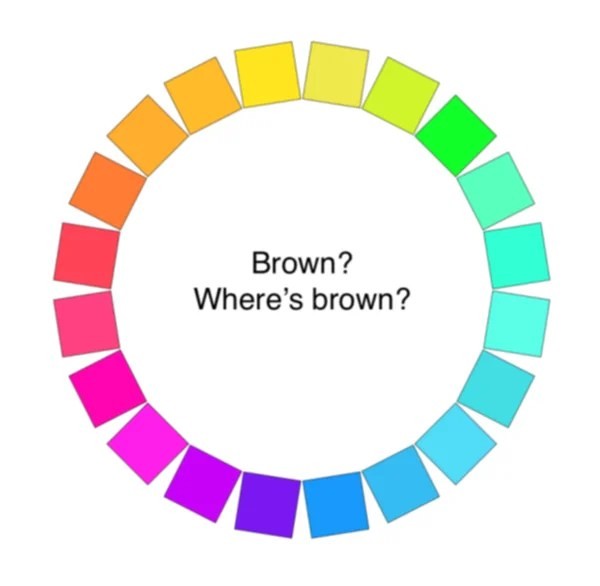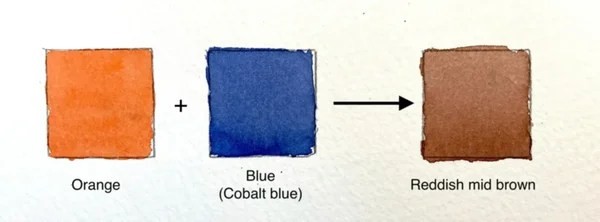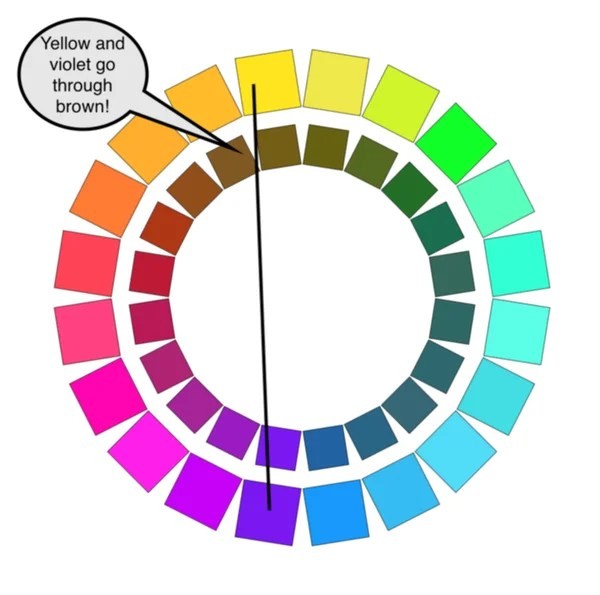What colors make brown? This is a common question, and at WHAT.EDU.VN, we can tell you that achieving the perfect brown involves understanding color theory and experimentation with different combinations, so you can get the right shade of brown for your artistic endeavors. Explore the possibilities of color mixing, learn how to create various shades of brown, and discover the secrets of color manipulation for stunning results, let’s explore earthy tones, color saturation, and complementary hues.
1. What Exactly is the Color Brown?
Before diving into the mixing process, it’s important to understand what brown actually is. Unlike primary colors like red, yellow, and blue, brown isn’t typically found on a standard color wheel. Instead, it’s a composite color, created by combining other colors. Think of brown as a darkened or desaturated version of orange. To truly understand what colors make brown, it’s essential to look at how colors interact with each other.
2. Where Does Brown Reside on the Color Wheel?
Brown isn’t explicitly present on a traditional saturated color wheel, because the color wheel typically showcases the purest, most vibrant colors, which are highly saturated. Brown is a color created by desaturating these vibrant colors. If you were to desaturate the colors on the color wheel, you would find brown in the range of the darker oranges and yellows.
3. Can Orange and Black Make Brown?
Yes, one straightforward method involves blending orange with black. Start with an orange base and gradually introduce black until you achieve your desired brown shade. This is because orange is a warm color, and adding black simply darkens it into a brown hue. This method is great for creating darker shades of brown.
4. How About Red, Yellow, and Black?
Combining red, yellow, and black can also yield brown, because red and yellow make orange, then adding black darkens it to brown. This approach offers more control over the warmth and depth of the brown. Experiment with different ratios to customize the color to your liking.
5. Using the Color Wheel: Connecting Colors for Brown
A helpful rule of thumb in color mixing is that if you draw a line between two colors on the color wheel, the resulting mix will fall somewhere along that line. This means that colors opposite each other or adjacent can be combined to create various shades of brown, depending on their proximity to the brown section.
6. Can Red, Blue, and Yellow Combine to Make Brown?
Yes, the classic recipe for brown involves mixing red, blue, and yellow, because these three primary colors can be combined to create a wide range of colors, including brown. Start with equal parts of each color, then adjust the ratios to fine-tune the shade of brown you want.
7. Does Orange and Blue Create Brown?
Absolutely, combining orange and blue is another effective way to produce brown, because orange and blue are complementary colors. When mixed, they neutralize each other to create a muted, earthy tone. Experiment with different proportions to achieve various brown shades.
8. Can Red and Green Produce Brown?
Yes, red and green can mix to make brown, because red and green are also complementary colors. Like orange and blue, they neutralize each other when combined, resulting in a brown hue. Adjust the ratios to control the warmth and depth of the brown.
9. What About Yellow and Purple?
Combining yellow and purple can indeed result in brown, although this combination might seem unconventional at first. Yellow and purple are near complements on the color wheel. Mixing them can produce a range of brownish tones, especially if the yellow has a slight orange bias.
10. What Are the Key Color Combinations for Brown?
In summary, here are the primary color combinations that can be used to create brown:
- Orange and black
- Orange and blue
- Red and green
- Yellow and purple
- Red, blue, and yellow
11. How Can I Mix Different Shades of Brown?
Once you’ve mastered the basics of creating brown, you can explore mixing different shades. Altering the ratios of your base colors allows you to create a wide spectrum of browns, from light tans to deep chocolates. Here are some tips:
12. What Colors Make Dark Brown?
To create dark brown, introduce more black or blue into your mixture, because black will deepen the tone, while blue will add a cooler, richer undertone. Experiment with small amounts of each until you reach your desired depth. Payne’s gray, a dark blue, is also effective for darkening brown.
13. What Colors Make Light Brown?
For lighter browns, add white or water to your mixture. White will lighten the color while maintaining opacity, while water will create a more transparent effect, ideal for watercolors. Be mindful that adding white can shift the hue slightly.
14. How About Gray Browns?
To create gray browns, focus on manipulating the chroma (color intensity) of your mixture. Introduce gray or complementary colors to desaturate the brown, resulting in a more muted, neutral tone. This is particularly useful for depicting natural elements like sand or aged wood.
15. Understanding Color Properties: Hue, Value, and Chroma
To gain a deeper understanding of color mixing, it’s helpful to understand the three basic properties of color: hue, value, and chroma.
15.1. What is Hue?
Hue refers to the name of the color, such as red, green, or yellow, corresponding to the colors on the outside of a standard color wheel.
15.2. What is Value?
Value refers to how light or dark a color is. This ranges from dark (0) to light (10). Understanding value is crucial for creating depth and contrast in your artwork.
15.3. What is Chroma?
Chroma refers to the intensity or saturation of a color. High chroma colors are bright and vibrant, while low chroma colors are muted and neutral. Adjusting chroma is essential for creating realistic and harmonious color palettes.
16. Why are Low Chroma Colors Important?
Low chroma colors are prevalent in nature and play a crucial role in creating realistic paintings. Many natural elements, such as sand, foliage, and stone, exhibit low chroma. It’s important to note that “Hue, Value and Chroma are independent,” which means that you can have a lower chroma color of the same value.
17. Can You Mix Higher Chroma?
It’s important to note that you can’t mix a higher chroma color from two lower chroma colors. High chroma pigments are essential for achieving vibrant colors that cannot be mixed.
18. What is the Role of Complementary Colors?
Complementary colors are pairs of colors that sit opposite each other on the color wheel, such as red and green, blue and orange, and yellow and purple. Mixing complementary colors can neutralize and desaturate a color, making them ideal for creating gray browns and muted tones. However, using complements requires careful adjustment to avoid unwanted hue shifts.
19. Adding Black or Gray to Lower Chroma
Adding black or gray to a color is a straightforward way to lower its chroma. This technique is particularly useful for creating low chroma browns with a neutral tone. By adding gray or black, you can achieve a range of muted browns suitable for various applications.
20. What About Primary, Secondary, and Tertiary Colors?
Understanding primary, secondary, and tertiary colors can be helpful, but it’s not essential for mixing browns. Primary colors (red, blue, and yellow) are the foundation of all other colors, while secondary colors (orange, green, and purple) are created by mixing two primary colors. Tertiary colors are mixtures of primary and secondary colors.
21. Color Mixing Techniques: A Summary Table
| Combination | Result | Notes |
|---|---|---|
| Orange + Black | Dark Brown | Good for deep, rich browns |
| Red + Yellow + Black | Customizable Brown | Offers control over warmth and depth |
| Red + Blue + Yellow | Classic Brown | The fundamental mix for creating brown |
| Orange + Blue | Muted Brown | Creates earthy tones |
| Red + Green | Earthy Brown | Adjust ratios for warmth and depth |
| Yellow + Purple | Variable Brown | Depending on bias, can create interesting hues |
| Brown + Black | Darker Brown | Deepens the tone, adds richness |
| Brown + White/Water | Lighter Brown | Creates transparent effects, may shift the hue |
| Brown + Gray/Complement | Gray Brown | Mutes the color, useful for natural elements |
| Payne’s Gray (Dark Blue) | Rich, Dark Brown | Enhances depth and coolness |





22. Practical Tips for Mixing Brown
22.1. Start with Small Amounts
When mixing colors, always start with small amounts and gradually add more until you achieve your desired shade, because it’s easier to add more color than to remove it.
22.2. Keep Records
Keep records of your color mixtures, noting the ratios of each color, because this will help you replicate your results in the future and build a library of custom browns.
22.3. Experiment
Don’t be afraid to experiment with different color combinations and ratios, because the possibilities are endless, and you might discover a unique shade of brown that you love.
22.4. Use Quality Paints
Use high-quality paints with good pigment saturation, because this will make the mixing process easier and more predictable.
22.5. Consider the Medium
Consider the painting medium you’re using (watercolor, oil, acrylic), because each medium has its own properties and mixing characteristics.
23. FAQ: Understanding the Nuances of Mixing Brown
| Question | Answer |
|---|---|
| Can I mix brown with only two colors? | Yes, you can mix brown with various two-color combinations like orange and blue, or red and green. |
| What if my brown is too red? | If your brown is too red, add a touch of green to neutralize the red hue. |
| How do I prevent my brown from looking muddy? | Avoid overmixing colors, because this can result in a muddy appearance. Mix colors gently and sparingly to maintain clarity. |
| Can I use pre-made brown paint? | Yes, you can use pre-made brown paint as a base, but mixing your own browns gives you more control over the final shade. |
| What’s the best way to test my brown mix? | Test your brown mix on a scrap piece of paper or canvas to see how it looks in different lighting conditions before applying it to your artwork. |
| Can I mix brown with watercolors? | Yes, you can mix brown with watercolors by layering different washes of complementary colors like red and green or blue and orange. |
| How do I create a warm brown? | To create a warm brown, add more red or yellow to your mixture, because these colors will impart warmth to the brown hue. |
| What if my brown is too dark? | If your brown is too dark, add white or water to lighten the color, and start with small amounts to avoid over-lightening. |
| Can I mix brown with acrylics? | Yes, you can mix brown with acrylics by blending complementary colors or by adding black, white, or umber to adjust the value and chroma. |
| How do I create a cool brown? | To create a cool brown, add more blue to your mixture, because blue will give it a cooler undertone. |
24. Unleash Your Creativity with Brown
Mixing colors to create brown opens up a world of creative possibilities. Whether you’re a painter, illustrator, or digital artist, understanding the principles of color mixing will empower you to create stunning artwork with depth, nuance, and realism. So grab your palette, experiment with different color combinations, and unleash your creativity with the versatile and timeless color of brown. Remember, the perfect shade of brown is just a mix away!
25. Still Have Questions About Color Mixing?
Do you find it challenging to get the right shade of brown? Are you unsure about which colors to mix? Don’t worry! At WHAT.EDU.VN, we offer a platform where you can ask any question and receive free answers from our community of experts. Whether you’re struggling with color theory, need tips on specific color combinations, or want advice on painting techniques, our knowledgeable users are here to help.
26. Get Your Questions Answered for Free!
WHAT.EDU.VN is your go-to resource for free, reliable answers to all your questions. Forget about spending hours searching online or paying for expensive consultations. With our user-friendly platform, you can quickly and easily submit your questions and receive personalized responses from experienced professionals and enthusiasts.
27. Why Choose WHAT.EDU.VN?
- Free Answers: Get expert advice without spending a dime.
- Fast Responses: Receive timely answers to your questions.
- Knowledgeable Community: Connect with a community of experts and enthusiasts.
- Easy to Use: Our platform is simple and intuitive, making it easy to ask and receive answers.
- Comprehensive Support: Get help with a wide range of topics, from color mixing to advanced painting techniques.
28. Don’t Struggle Alone – Ask WHAT.EDU.VN!
Whether you’re a beginner or an experienced artist, WHAT.EDU.VN is here to support you on your creative journey. Don’t let your questions go unanswered – visit our website today and get the free advice you need to master the art of color mixing.
Contact Us:
- Address: 888 Question City Plaza, Seattle, WA 98101, United States
- WhatsApp: +1 (206) 555-7890
- Website: WHAT.EDU.VN
29. Ready to Get Started?
Take the first step towards mastering color mixing and visit what.edu.vn now. Ask your questions, get free answers, and unlock your creative potential. Join our community today and discover the endless possibilities of color!